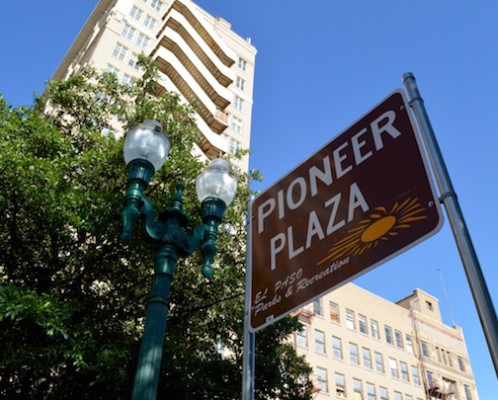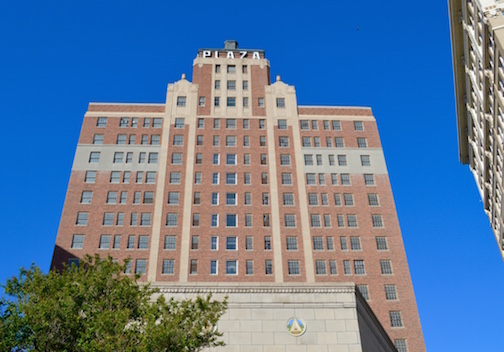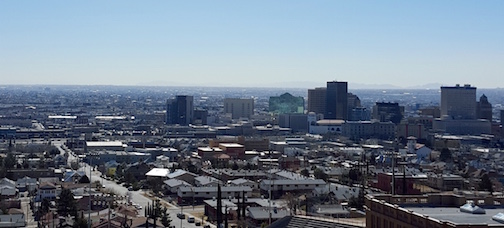El Paso is a special place with a long history. You may have heard of Mexican Revolutionary leader Pancho Villa’s visits to El Paso or the roaming alligators in San Jacinto Plaza. Over the years there has also been a lot of change in the Sun City. A recent lecture at the El Paso Museum of History with historian Fred Morales inspired this look back through time into how some familiar spots used to be in days gone by.
1. Cleveland Square

A visit to Cleveland Square Park in Downtown El Paso today may find people playing with the digital wall at the the El Paso Museum of History while listening to the cheering crowds at nearby Southwest University Park where the El Paso Chihuahuas Triple A baseball team plays. But many may not know the area was initially a resting place for the dead.
The area around the ballpark’s right field, near the intersection of Santa Fe and Franklin, was known as Campo Santo (Saint’s Field) or Blessed Field. A Sept. 25, 2013 article by Mark Cioc Ortega in the former online news site Newspaper Tree describes the cemetery as the closest thing El Paso had to a “boot hill” where early settlers and gunslingers were laid to rest.
When Fort Bliss was established near Hart’s Mill in 1878, El Paso pioneer Simeon Hart gave land to expand Campo Santo for a military burial ground in the area where Cleveland Square is now. The soldiers bodies were exhumed and moved when Fort Bliss relocated to its current site in the 1890s.
By 1908 Cleveland Square was transformed into a community gathering spot featuring a bandshell for concerts. Bands performed regularly, including musician Trinidad Concha, the popular music arranger for the McGinty Club Band. The area was also a popular site for political rallies and religious services. Now, Cleveland Square’s biggest musical attraction is the Neon Desert Music Festival.
2. Pioneer Plaza

The Plaza Hotel currently sits in front of Pioneer Plaza. Mid-winter carnival brought in crowds, Morales said. Guests could participate in games and contests at the carnival. In one game contestants would use machines to drill holes into a granite block. The contender that dug the deepest hole in a certain amount of time won. The granite block full of holes can be seen today in Memorial Park.
3. Concordia Cemetery

Dating back to the 1880s, Concordia Cemetery in central El Paso is famous for being the resting place of notorious gunslinger John Wesley Hardin. The cemetery, which lies just below I-10’s “Spaghetti Bowl,” began as a ranch owned by Hugh Stephenson and his wife Juana Maria Ascarte.
To the south of Concordia was a union stockyard where thousands of cattle were herded. San José de Concordia el Alto, one of El Paso’s oldest Catholic churches built in 1850, stood in the middle of the stockyards until the 1930s.
4. Union Plaza District

The Union Plaza district is a trendy Downtown hotspot for entertainment and nightlife. But in 1901, Union Plaza was home to El Paso’s largest brass foundry. Located in the area of Anthony Street to Durango and from San Francisco to San Antonio, the foundry was considered a major employer to residents in El Paso.
5. Before the Union Depot

The Union Depot stands out in the view from El Paso’s freeway with its red brick structure and green spire. The depot’s grand opening in 1906 attracted a crowd of 10,000 people. The depot served 22 trains a day during its first year of operation. Trolley service was provided from the train station on a circuit through Downtown.
But before the depot was established this location was where Asarco first got started. In 1885 a man named Robert Towne built a small plant on the site – a sampling mill with a smokestack. But by 1887 Asarco moved to its new location in the area that became known as Smeltertown.
6. Plaza Hotel

In 1902, there were 86 saloons in the Sun City. The Coney Island Saloon and Bar is probably the most noted. It was located where the Plaza Hotel stands at the corner of Sheldon and Oregon Streets.
In 1908, Mannen Clements, cousin of gunslinger John Wesley Hardin, was fatally shot at the saloon in one of the last Old-West-style gunfights. During that time El Paso Mayor Ben Hammett started a campaign against gamblers and saloon keepers because of the lawlessness, Morales said.

